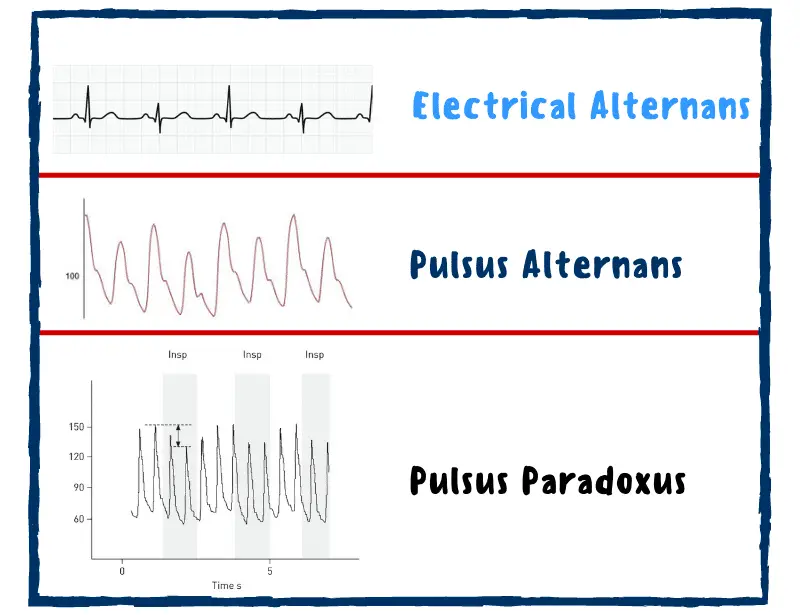Pulsus Alternans
Pulsus alternans is a phenomenon which occurs with the failing ventricles of the heart. It was first described in 1872 by Ludwig Traube.
Pulsus alternans is characterized by a regular pattern of strong arterial pulse followed by a weak pulse.
Although there are three distinct pulsus alternans, it is most commonly seen in severe left ventricular heart failure. Namely, biventricular alternans, right ventricular alternans, and left ventricular alternans.
What are the causes of pulsus alternans?
The cause of pulsus alternans will depend on the underlying problem of the lower chambers of the heart.
The problem may be in either the left ventricle or right ventricle or both the ventricles.
Causes for left ventricular alternans include:
- Cardiomyopathy
- Aortic stenosis
- Coronary artery disease
- left-sided heart failure
Causes for right ventricular alternans include:
- Pulmonary embolism
- Pulmonary hypertension
- Reactive airway disease
- Mitral stenosis
- Left -sided heart failure
Causes for biventricular alternans include:
Biventricular alternans is a very rare phenomenon which may occur with,
- Severe left ventricular dysfunction
- Left anterior descending coronary artery disease
What are the signs and symptoms of pulsus alternans?
Signs and symptoms of pulsus alternans include:
- Elevated jugular venous pressure (JVP)
- Bibasilar rales
- Peripheral edema
- Presence of S3, or S4 heart sound
- Tachycardia
- Tachypnea
- Hypotension
Treatment for pulsus alternans
Since there are three main pathologies involved in pulsus alternans, the treatment will depend on the underlying cause.
For example, severe aortic stenosis would require aortic valve replacement, while a pulmonary embolism will need anticoagulation therapy.
How to assess pulsus alternans
You can assess for pulsus alternans during physical examination either by palpating the radial or femoral pulse. Then, observe the regularity of the rhythm and quality of the pulse. If you feel a regular pulse but its strength is alternating between strong and weak pulses is suggestive of pulsus alternans.
Another way of assessing pulsus alternans is while taking manual BP. First, inflate the cuff pressure above systolic BP and gradually deflate the cuff while carefully listening to the Korotkoff sounds. If you notice a strong and faint sound indicates the presence of pulsus alternans.
In addition, you can observe the pulsus alternans phenomenon through arterial pulse waveform on the cardiac monitor.
Pulsus Alternans vs Pulsus Paradoxus
| Pulsus alternans | Pulsus paradoxus | |
| Description | A regular alternating pattern of a weak and strong pulse | A drop in systolic blood pressure more than 10 mmHg during inspiration |
| Causes | Left-sided heart failure Cardiomyopathy Aortic stenosis Coronary artery disease | Pericardial tamponade Advanced heart failure Constrictive pericarditis |
Pulsus Aalternans vs Pulsus Bigeminus
| Pulsus alternans | Pulsus bigeminus | |
| Description | A regular alternating pattern of a weak and strong pulse | Similar to pulsus alternans but occurs at irregular intervals |
| Causes | Left-sided heart failure | Premature atrial ventricular beats |
Electrical Alternans vs Pulsus Alternans
| Pulsus alternans | Electrical alternans | |
| Description | A regular alternating pattern of a weak and strong pulse | Alternating amplitude of QRS complexes in all or single lead on ECG [EKG] without obvious changes in heart’s conduction pathways. |
| Causes | Left-sided heart failure Cardiomyopathy Aortic stenosis Coronary artery disease Pulmonary embolism Pulmonary hypertension | Pericardial effusion Ventricular tachycardia Wolff-Parkinson-White (WPW) Accelerated idioventricular rhythm Supraventricular tachycardia (SVT) |
Conclusion
Unlike pulsus paradoxus and electrical alternans, pulsus alternans is an abnormality of the arterial pulse, where it alternates between strong and weak beats with a regular rhythm.
So, pulsus alternans is not to be confused with pulsus paradoxus and electrical alternans.
Reference
Burns, S., & Delgado, S. (2019). AACN Essentials of Critical Care Nursing (4th ed.). The McGraw-Hill Companies.
Griffin, B., Menon, V., Wiggins, N., Bumgarner, J., & Huded, C. (2019). Manual of cardiovascular medicine (5th ed.). Wolters Kluwer.McLaughlin, M. (2015). Cardiovascular Care Made Incredibly Easy (3rd ed.). Wolters Kluwer.





